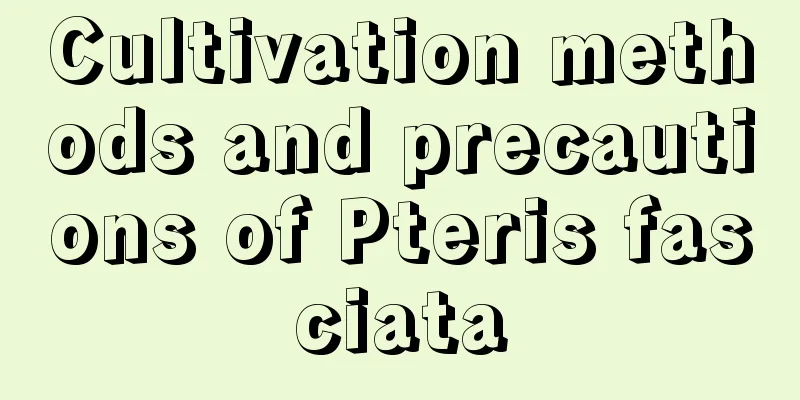Cultivation methods and precautions of Pteris fasciata

How to grow Pteris fernPot soilThe phoenix fern is highly adaptable and has low requirements for soil, but fertile and well-drained soil is preferred, and soil with a high calcium content is best. For potted plants, you can choose plastic pots with strong water retention, and use a substrate mixed with peat soil and garden soil. Broken bricks can be placed at the bottom of the pot as a drainage layer. Light and humidity managementThe phoenix fern likes a semi-shady environment and should avoid direct sunlight. Scattered light is preferred. The growth of phoenix fern requires higher humidity and is not resistant to dryness, so it needs to be sprayed with water frequently to maintain humidity. Too much light will cause the leaves of the fern to shrink and wilt, while insufficient humidity will cause the leaves of the fern to turn yellow. Therefore, it is necessary to manage light and humidity well. Temperature requirementsThe phoenix fern prefers a warm growing environment and requires a growth temperature between 16℃ and 28℃. The wintering temperature cannot be lower than 5℃. It needs to be kept warm and placed in a warm room. In summer, the purpose of cooling can be achieved by providing shade, increasing ventilation, and spraying water. Water and fertilizer managementThe phoenix fern likes moisture, but is afraid of waterlogging, so it is better to water it to make the soil in the pot moist. During the growth period, water frequently, once every 2 to 3 days, and spray water frequently to maintain humidity. In winter, water less and just keep the soil in the pot slightly moist. Fertilization needs to be done thinly and frequently. During the growth period, apply thin liquid fertilizer once every half a month. When repotting, you can apply sufficient base fertilizer. Reproduction methodIt should be noted that the phoenix fern has no flowers and no seeds. It is mainly propagated by division, but it can also be propagated by asexual spores. Precautions for the cultivation of Pteris fernPests and diseasesDuring the growth process of Pteris fern, pests such as aphids and red spiders, as well as root rot may endanger the health of the plant. It is necessary to use pesticides for prevention and control, and do daily management work. Winter yellow leavesWhen the temperature is too low, many yellow leaves will appear on the fern. At this time, be careful not to rush to cut off the yellow leaves of the fern, as the yellow leaves can also transport the nutrients stored in themselves to the new leaves.
|
<<: Cultivation methods and precautions of lotus leaf peperomia
>>: Cultivation methods and precautions of Linaloa
Recommend
If you grow jasmine like this in summer, the flower buds will pop non-stop and will bloom for half a year!
What should I do if the leaves of jasmine turn ye...
Can pear trees be planted in the yard?
Can I plant a pear tree in my yard? Pear trees ca...
How to fertilize celery to make it grow better?
Celery originates from plants in the Mediterranea...
Several green plants with drug-absorbing effects
Osmanthus fragrans Osmanthus is a traditional fam...
Prevention and control methods of asparagus fern blight and yellowing disease
Branch blight of Asparagus fern Dieback disease s...
How to deal with Clivia not blooming
1. Get more sun The reason why Clivia does not bl...
How many days does it take for onions to sprout?
Scallions are a common root vegetable in people’s...
How to propagate Sophora japonica
How to propagate Sophora japonica Seed propagatio...
Saffron cultivation methods and precautions
Saffron has strong resistance to adversity and is...
Pingyao Ancient City is flooded and walls collapsed; heavy rains in Shanxi cause scenic spots to be closed
For Shanxi, this year's National Day holiday ...
How often should you change the soil for succulents?
Need to change soil When growing succulents, chan...
When is the best month to plant snow peas?
When to plant snow peas Snow peas are suitable fo...
How to water the anthemum
Watering tips for anthemis In spring, summer and ...
Why do we need to grow three lucky bamboos?
1. Reasons for raising three roots Many people li...
What is the calla lily flower called?
Other names for calla lily The scar taro, wolfsba...









